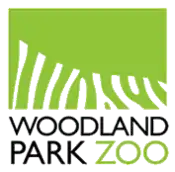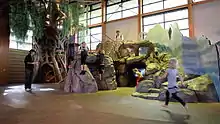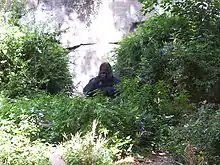Woodland Park Zoo
Woodland Park Zoo is a wildlife conservation organization and zoological garden located in the Phinney Ridge neighborhood of Seattle, Washington, United States. It is the recipient of over 65 awards across multiple categories, and has served approximately 1.4 million domestic & international visitors in 2019.
 | |
| Date opened | 1899 |
|---|---|
| Location | Woodland Park, Seattle, Washington, U.S. |
| Coordinates | 47.66834°N 122.34984°W |
| Land area | 92 acres (37 ha) |
| No. of animals | 1,098 [1] |
| No. of species | 300 [1] |
| Memberships | AZA[2] |
| Major exhibits | Trail of Vines, Northern Trail, Tropical Rain Forest, Banyan Wilds, African Savanna |
| Website | www |

History
Occupying the western half of Woodland Park, the zoo began as a small menagerie on the estate of Guy C. Phinney, a Canadian-born lumber mill owner and real estate developer. Six years after Phinney's death, on December 28, 1899, Phinney's wife sold the 188-acre (76 ha) Woodland Park to the city for $5,000 in cash and the assumption of a $95,000 mortgage. The sum was so large that then-mayor W. D. Wood vetoed the acquisition, only to be later overruled by the city council. In 1902, the Olmsted Brothers firm of Boston was hired to design the city's parks, including Woodland Park, and the next year the collection of the private Leschi Park menagerie was moved to Phinney Ridge.
In 1975, David Hancocks, the then-director of the Woodland Park zoo, redesigned the zoo's gorilla exhibit to form what became referred to as landscape immersion exhibits, in which animals would become immersed in landscapes that represented their natural habitats as closely as possible, while visitors would also be immersed in the same replicated habitat.[3] The habitat was designed with natural plants and rockwork, with special consideration being put towards the acoustic treatment of the exhibit to make the environment soft and quiet. Initially the idea was heavily criticized, with many experts being concerned about the maintenance of vegetation and lack of visibility, as well as the temperate environment of Washington negatively affecting the soil. The idea eventually became the standard for naturalistic exhibits, inspiring many imitators and replicas worldwide.[4]
As of the summer of 2010, the zoo features 92 acres (37 ha) of exhibits and public spaces. Open to the public daily,[5] it received 1.05 million visitors in 2006. Its collection includes:
- 1,090 animal specimens
- 300 animal species
- 35 endangered and 5 threatened animal species
- 7,000 trees
- 50,000+ shrubs and herbs
- 1,000+ plant species
- A sensory garden[6]
Exhibits
Woodland Park Zoo is a recipient of several Best National Exhibit awards from the Association of Zoos and Aquariums, and ranks second after the Bronx Zoo in New York City for the number received.[7] Woodland Park Zoo created what is generally considered the world's first immersion exhibit, a gorilla habitat, which opened in the late 1970s under the direction of zoo architect David Hancocks.[8] Other exhibits include:


- Tropical Asia is the zoo’s largest section, focusing on Asian jungle and grassland animals, and is split into three areas. The first is Assam Rhino Reserve and is mostly composed of a large exhibit containing the zoo's first male Indian rhinoceroses. Nearby are smaller enclosures for Asian forest tortoise, demoiselle crane, and Visayan warty pig. The second area is Bayan Wilds and is home to Malayan tigers, sloth bears, Asian small-clawed otters, and a small aviary. The third section is The Trail of Vines and houses orangutans, siamangs, pythons, Malayan tapir, and François' langur. The Rhino Reserve was previously the Elephant Forest but was rethemed following the phasing out of the zoo’s elephant program in April 2015.
- The African Savanna section houses animals native to the grasslands of Africa. The largest exhibit is an area for herbivores, home to giraffes, zebras, and ostrich. There are as well enclosures for hippo, African lion, warthog, Patas monkey, and a small aviary for savanna birds. The area also contains a recreation of an East African village. The African Savana won the AZA exhibit award in 1981.
- Australasia is home to the zoo’s Australian species. There is an outdoor exhibit shared by emu, common wallaroo, and red-necked wallaby. Next to it is Willawong Station, housing several species of Australian parrot, which visitors may feed for a small fee.
- The Northern Trail habitat focuses upon the animals of the taiga. Exhibits include grizzly bear, porcupine, mountain goat, elk, and wolf. This area is modeled off a real trail in Alaska’s Denali National Park and won the AZA Exhibit Award in 1995.
- Tropical Rainforest explores the animals of South America and Africa’s jungles. The South American section has a jaguar exhibit and a rainforest house that is home to dozens of Amazonian species, including poison dart frogs, yellow anaconda, ocelot, and golden lion tamarin. The African section contains western lowland gorillas, ring-tailed lemurs, red ruffed lemurs, and colobus monkeys. Tropical Rainforest was the recipient of the AZA Exhibit Award in 1993.
- Temperate Forest showcases creatures of the world’s temperate woodlands. Exhibits include southern pudu, red panda, Chilean flamingo, a wetlands area, and a conservation aviary for rare birds. There is also a Bug House, home to the zoo’s invertebrate collection, and a farm exhibit, allowing guests to pet domesticated animals.
- The penguin enclosure houses a colony of several dozen Humboldt penguins. The exhibit was remodeled in 2009 to allow underwater viewing of the birds and better theming to their natural habitat; it also now runs on green energy. The new penguin habitat received the AZA Top Honor Award in 2010.
- Also at the zoo is a snow leopard habitat, a butterfly garden, a raptor center housing various birds of prey, and the Trail of Adaptations building that is home to Komodo dragon, meerkat, Indian flying fox, and sloth.

- The zoo contains an indoor children’s play area called Zoomazium, encouraging exploration, exercise, education, and fun for young children. An old-fashioned carousel retooled to run on solar energy is also featured. This merry-go-round (PTC #45) was first built by the Philadelphia Toboggan Company for the Cincinnati Zoo in 1918, it was refurbished and donated to Woodland Park Zoo by Alleniana Foundation.
Community engagement
Woodland Park Zoo has been an active member of environmental and ecological conservation efforts across the U.S. Besides operating its own educational programs for school children, the park also cooperates with many of the higher education institutions in state, such as the University of Washington. On January 5, 2010, the zoo announced that due to the "difficult economy," it would be closing its Night Exhibit.[9][10]
Notable animals

From 1953 to 1968, Woodland Park Zoo was home to Bobo, a western lowland gorilla (Gorilla gorilla gorilla, the same species as the gorillas currently living at the zoo). Bobo was acquired from the Lowman family of Anacortes, Washington, who had purchased the gorilla as an infant from a hunter in Columbus, Ohio in 1951 and had raised him in their family home in Anacortes. Bobo drew many visitors to the zoo and was one of Seattle's main attractions in the years preceding the construction of Seattle Center and the expansion of major-league professional sports into the city. His popularity is credited with helping the zoo obtain funding to build a new primate house.
Anthropologist Dawn Prince-Hughes spent many years working at Woodland Park Zoo and observing the western lowland gorillas there, which she wrote about in her book Songs of the Gorilla Nation: My Journey Through Autism.[11]
Two lionesses named Busela (Seyla) and Nobuhle (Nabu) were transferred from the zoo to Hogle Zoo in Salt Lake City, Utah to breed with the Montgomery Zoo's two male lions, Baron and Vulcan.[12] On February 24, 2016, Nabu gave birth to two males, Brutus and Titus, and a female, Calliope. Baron fathered the three cubs.[13]
In December 2015 a baby gorilla, Yola, was born at the zoo. She is the first child of Nadiri who was also born there.[14]
On June 20, 2017, the baby giraffe Lulu was born, weighing 5'7" and 149 lbs. The daughter of Tufani and Dave, she is a mixture of the reticulated and South African giraffe subspecies. Her naming rights were auctioned off at the zoo's Jungle Safari Party fundraiser.[15] A male snow leopard cub was also born at the zoo that summer; he was given the name of Aibeck, meaning "long life" in Kyrgyz.[16]
References
- "Archived copy". Archived from the original on November 12, 2006. Retrieved 2006-10-23.CS1 maint: archived copy as title (link) retrieved October 22, 2006
- "Currently Accredited Zoos and Aquariums". aza.org. AZA. Retrieved 25 February 2011.
- "A Critical Look at the Future of Zoos--An Interview with David Hancocks". National Geographic Society Newsroom. 2012-03-13. Retrieved 2020-11-17.
- "David Hancocks | The Paradoxical World of Zoos". Conservation Careers. 2018-08-24. Retrieved 2020-11-17.
- "Hours, Prices and Directions - Woodland Park Zoo Seattle WA". www.zoo.org. Retrieved 2018-03-20.
- "Sensory Garden @ Woodland Park Zoo" (PDF). Seattle Parks and Recreation. 2015-09-10.
- "Exhibit Awards", Association of Zoos & Aquariums, 2014-10-12
- Schaul, Jordan Carlton (2012-03-13), "A Critical Look at the Future of Zoos–An Interview with David Hancocks", National Geographic, archived from the original on 2012-03-17
- Woodland Park Zoo STATEMENT: Night Exhibit ("Nocturnal House") Closure, Woodland Park Zoo, 2010-01-05. Accessed online 2010-01-07.
- "Woodland Park Zoo to close Night Exhibit". mynorthwest.co. Bonneville International. 21 January 2010. Retrieved 25 February 2011.
- Prince-Hughes, Dawn (1987). Songs of the Gorilla Nation. Harmony. p. 77. ISBN 1-4000-5058-8.
- "Archived copy". Archived from the original on 2015-09-26. Retrieved 2015-07-27.CS1 maint: archived copy as title (link)
- Gorrell, Mike (2016-05-17). "Hogle Zoo's adorable new lion cubs meet the world". The Salt Lake Tribune. Retrieved 2018-09-04.
- Lee, Jessica (2016-06-06). "Baby gorilla at Woodland Park Zoo to make public debut". The Seattle Times. Retrieved 2018-09-04.
- Allianic, Gigi. "The baby giraffe has a name! Woodland Park Zoo announces name of baby giraffe". Woodland Park Zoo. Retrieved 15 January 2018.
- Ellouk, Bernard (2017-09-19). "Snow leopard cub makes first public appearance at Woodland Park Zoo". KING. Retrieved 2018-09-04.
External links
| Wikimedia Commons has media related to Woodland Park Zoo. |